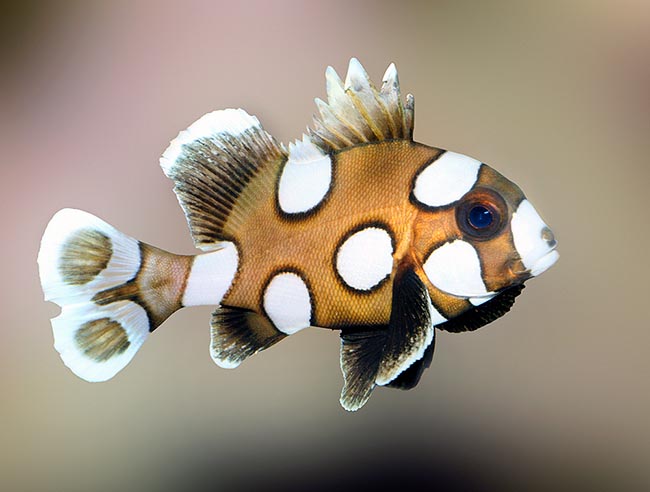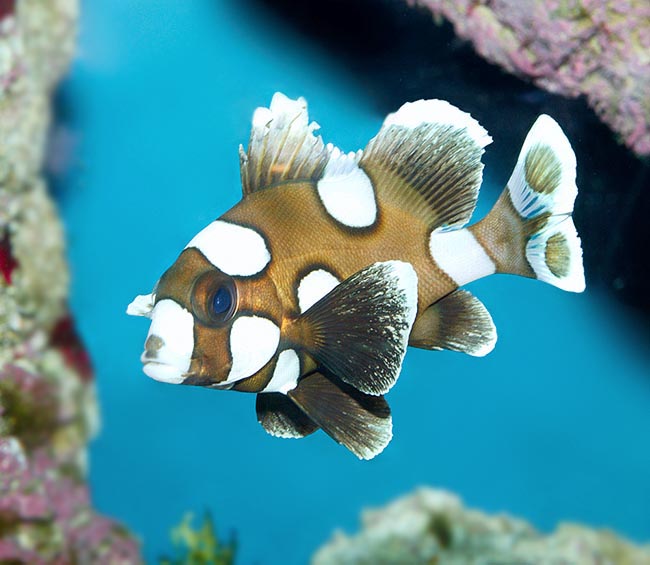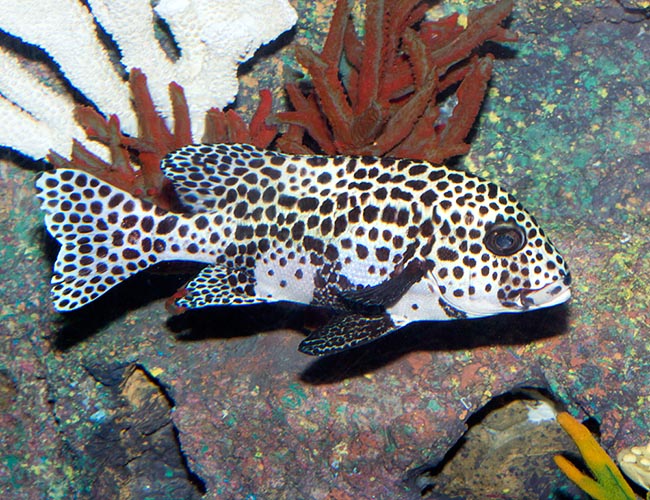Family : Haemulidae

Text © Giuseppe Mazza

English translation by Mario Beltramini

Too caught, to finish miserably in the domestic aquaria, Plectorhinchus chaetodonoides is at home in the Indo-Pacific tropical waters where it wears this odd clown livery up to about 10 cm of size © Giuseppe Mazza
The Harlequin sweetlips, also called Clown sweetlips (Plectorhinchus chaetodonoides Lacepède, 1801), belongs to the class of Actinopterygii, the ray-finned fishes, to the immense order of Perciformes and to the family of Haemulidae, that counts 23 genera and 135 species.
Almost exclusively marine fishes, that rarely exceed the 60 cm and that occupy, aquaria apart, an important role in the human alimen- tation.
The name of the genus Plectorhinchus comes from the Greek “epiplektos” = twined and “rygcos” = snout, with reference to the big lips rich of folds.
The specific name chaetodonoides means that it resembles a Chaetodon, the butterflyfishes belonging to the fami- ly of Chaetodontids (Chaetodontidae), and this not because of a physical resemblance but due to the imaginative patterns and movements of the juvenile form that may lead to think to the butterflies.
Zoogeography
The Plectorhinchus chaetodonoides is at home in the Indo-Pacific tropical waters.

Also the young moving way, with fluttering dances head down, is quite different from the adult swimming © Giuseppe Mazza
Ecology-Habitat
It lives among the madreporic forma- tions, often in lagoons, but also in the brackish waters of the estuaries. It usually does not go down under the 30 m of depth.
Morpho-physiology
It may reach the 7 kg with more than 70 cm of length, even if the normal size, more mdest, is around the 60 cm.
The oval, flat body, shows big fleshy lips and a bilobed tail in the young that then, with the time, becomes bi-forked.
The dorsal fin counts 11-12 spiny rays and 18-20 unarmed; the anal 3 spines and 7-8 unarmed rays; the ventral ones 1 spiny ray and 5 soft and the pectoral 16-17 unarmed rays. What is most surprising is the difference in shape, pattern and colour between the young and the adults.
The juvenile forms, up to about 10 cm, show a pale brown livery and few big white spots circled by dark that break the outline for camouflaging reasons also imitating, as deterrent, a poisonous worm.
The adults, almost unrecognizable, may reach the 7 kg with more than 70 cm of length © Giuseppe Mazza
The adults, perfectly opposite, swim normally showing a clear, yellowish or greenish, bottom, with countless dark brown spots. The subadults, up to about 20 cm, show on the contrary, an almost white bottom and very dark relatively big spots.

The subadults, up to about 20 cm of size, show this intermediate livery where, roughly, the passage can be sensed © Giuseppe Mazza
Ethology-Reproductive Biology
Plectorhinchus chaetodonoides is a mainly nocturnal fish that nourishes of molluscs, crustaceans and small fishes.
The adults spend often the day hidden in submerged grottoes uniting only for the reproduction offshore.
The growth of the larvae is very slow and even 14 years are needed for doubling the populations decimated by the events. Therefore, the resilience is low and seen the merciless fishing of the young for the aquaria trade, the vulnerability index of the species has already risen to 54 on a scale of 100.
Synonyms
Gaterin chaetodonoides Lacepède, 1801.
→ For general information about FISH please click here.
→ For general information about BONY FISH please click here
→ For general information about CARTILAGINOUS FISH please click here.
→ To appreciate the BIODIVERSITY of BONY FISH please click here.
→ To appreciate the BIODIVERSITY of CARTILAGINOUS FISH please click here.
